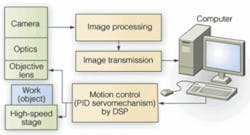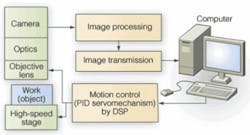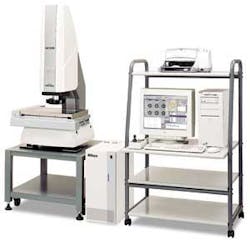Microscope system inspects bump-grid arrays
By Andrew Wilson
Inspecting bump-grid array (BGA) packages is a challenging task because the Rayleigh limit in visible light keeps the typical field of view (FOV) under 0.3 mm. To create an automated inspection system capable of measuring BGA packages and larger packages several millimeters across, Nikon Instruments (Melville, NY, USA; www.nikonusa.com) mated a compound video microscope with computer-controlled ball-screw slides. With a turret-mounted objective with a 0.5X secondary lens, The NEXIVVMR LU optical system uses a 50X BD ACRO lens, which can resolve 0.37-μm features. This is the best match for imaging 8 × 8-mm die with 0.5-μm resolution.
To combine an unlimited number of high-resolution images into a single large-area image, a host computer controls the CNC’s three positioning axes, acquires individual images, and then processes them to create a final image (see figure). To capture 750 × 494 images, the NEXIV uses a JK-TU53H 1/3-in. CCD camera from Toshiba-Teli (Irvine, CA, USA; www.toshiba-teli.co.jp).
Stitching fields together accurately requires an overlap between adjacent fields. To overlap these fields by 5% on each side, adjacent fields must be separated by 0.356 mm horizontally and 0.234 mm vertically. To acquire such an array of images over an 8-mm-wide device, the computer steps the CNC position in a modified raster pattern 23 columns wide and 35 rows high, acquiring an image at each stop. The CNC system, which can position the microscope to within 0.1 μm, ensures that each field’s position is known within the microscope’s optical resolution.
To capture and process the images, Nikon used an 8100CX frame grabber and image-analysis software system from Cognex (Natick, MA, USA; www.cognex.com). The MVS-8100CX is a PC-based machine-vision hardware and software package that combines Intel’s MMX instruction set with Cognex’s machine-vision software.
Nikon was particularly interested in the system’s PatMax suite of vision tools, which uses pattern recognition to identify the features of interest in the presence of rotations, scale changes, and distortions. Nikon’s NEXIV Automeasure software invokes the PatMax resources through calls in Visual C++, the native language used for Automeasure.
To achieve measurement in the third dimension, Nikon exploited the fact that high-numerical-aperture lenses with high magnifications have a narrow depth of field. Using a vertically mounted leadscrew positioning slide to carry the microscope head allows the field center to be precisely located both in the horizontal plane and along the vertical (z) axis. The slide’s precision in the third dimension is the same (0.1 μm) as in the horizontal plane.
Instead of acquiring a single in-focus image for each microscope field, the system acquires several images at different heights throughout the sample. Postprocessing software determines which features are in focus at each depth, creating a 3-D representation of the surface in that field.
“This three-dimensional metrology system would not be possible without Cognex PatMax XLC,” says Michael Metzger, general manager of the Nikon industrial microscopy and metrology department, “because the tool allows pattern-matching to be performed even in poor-contrast situations.”
Metzger says the NEXIV VMR has applications beyond package inspection. Other applications include inspection of microelectromechanical systems that display high relief while requiring high-resolution measurements.


